This post was updated on October 18th, 2022.
Conversational marketing has been quite the buzzword recently, huh?
A conversational growth strategy can be valuable for your business, but first, we have to strip away the jargon behind phrases like "conversational growth strategy."
Conversational marketing takes advantage of the power of one-on-one conversations. It's a form of one-to-one marketing that can fill gaps in your marketing to answer your audience's questions in real-time, creating authentic experiences.
But conversational marketing, as the term is being used today, isn't just literally talking to your audience and trying to sell them stuff. There's already a word for converting leads—sales.
Instead, conversational marketing is about the rise of a new type of marketing technology—and about marketing trends in how people talk to each other online across multiple channels.
But what is it actually?
What makes it different?
How can you do it?
How can you do it well?
Table of Contents
What is conversational marketing?
Conversational marketing is an approach to marketing that lets businesses engage leads to having one-to-one personal experiences with the customer.
This makes it easier to answer questions in 24/7 real-time, improving lead generation and sales.
The definition of conversational marketing is intentionally broad. But even though there’s little mention of technology in that definition, most people referring to conversational marketing are talking about chatbots and live chat.
Let’s do quick definitions:
- What is live chat? Live chat is a communication channel you add to your website that lets visitors message a team member directly. That means you can offer assistance in real-time and save visitors the trouble of digging around your website.
- What are chatbots? Chatbots are software programs that mimic natural language and conversation. They can also be pre-programmed with targeted messages, which lets you get many of the benefits of live chat without needing someone to actively monitor chat windows.
Live chat and intelligent chatbots can be extremely helpful if you visit a website and have trouble finding personalized solutions. If your question is highly specific, it’s faster to ask a question than to find an answer on your own.
Live chat marketing has been around for a while, and it tends to be most helpful for people who are already close to making a decision (and just have a few final concerns).
Chatbot marketing, on the other hand, is relatively new. Because chatbots don’t take a real person to run 24/7, you can keep them active… 24 hours a day!
Many websites use intelligent chatbots to greet visitors and collect information (including contact information) in lead forms.
In a way, this type of chatbot marketing is a less annoying form of a pop-up.
Although pop-up lead capture forms are universally annoying, anyone who’s used 1 knows that they convert crazy better than other types of calls to action.
Data from Sumo shows that pop-ups, if done well, can hit high conversion rates. The top 10% of pop-ups in their sample converted at over 9%.
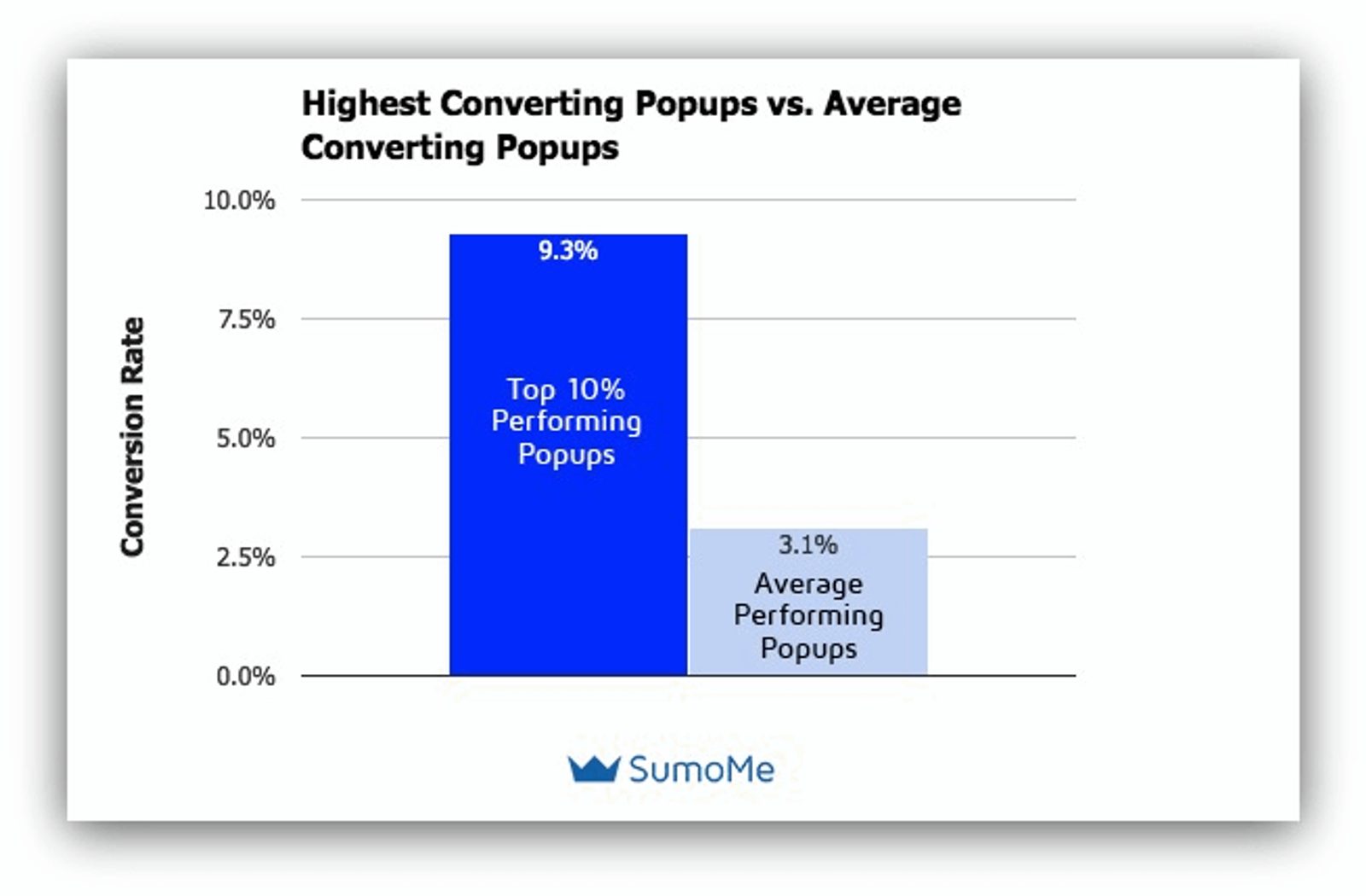
If you throw in retargeting pop-ups, exit-intent pop-ups, and pop-ups that only appear on scroll, the effectiveness of pop-ups is pretty high.
But they’re still annoying.
Chatbot marketing is relatively new, so there isn’t a lot of data on their conversion rates relative to pop-ups and other forms.
Still, an intelligent chatbot has a lot in common with a pop-up form in that it triggers a message that goes to website visitors. Because that message is in the form of a conversation, it may be less annoying.
And because conversations allow more interaction, you might be able to collect information and address key concerns at the same time.
The potential here is huge. You could:
- Collect information that lets you build a sales pipeline full of qualified leads
- Offer better customer service and a superior buying experience
- Address a pain point—which would be impossible if visitors were just filling out a lead form
- Ask qualifying questions so that sales teams can better understand potential customers
- Improve your sales cycle and save sales rep time—while giving a more personal experience that mimics face-to-face marketing
Even though conversational marketing is still young, it looks promising.
But where’d it come from? And why has conversational marketing strategy risen in popularity over more traditional marketing methods?
The history of conversational marketing (or how traditional marketing collapsed)
50 years ago, the marketing world looked different.
Most “marketers” were doing some form of advertising. TV ads, sponsorships, public relations, and direct mail ruled the day.
If you were a marketer, you were probably involved in some form of ad buying, copywriting, creative, or press release. Maybe you worked to negotiate endorsement deals or sponsorships.
Today’s marketing world is extraordinarily different. A marketing department today may still have copywriters and designers, but it also includes social media experts, paid search specialists, video production, SEO, and (of course) “growth hackers.”
What changed?
The history of conversational marketing goes back to the collapse of traditional marketing. As marketing channels became increasingly saturated, everyday life got cluttered with marketing messages.
If you were getting mail at some point in the 90s, you remember the piles and piles of junk.
Marketing just wasn’t working the way it used to. And the internet, a hot new channel with an uncertain future, was opening new doors in marketing.
Enter “Permission Marketing.”
This phrase, coined by marketing legend Seth Godin, speaks to the fundamental difference between new marketing and old marketing.
Traditional marketing was “interruptive.” It reached people in their everyday lives while they were trying to do something else.
It interrupted them from doing the things they really wanted to do.

Do you really want to sit through a television commercial to watch your favorite TV show?
Of course not. Commercials worked because there were few alternatives and a largely captive audience—but their days of effectiveness were numbered in a world that’d soon develop online streaming.
Permission marketing is instead about creating experiences that people want. It means having permission to market to people, but done well, it’s even more than that. It’s the idea that people should actively seek out your marketing because that’s just how good it is.
This idea of “creating things people want” led to the rise in content marketing—another fast-growing marketing trend.

Content marketing is diametrically opposed to interruptive marketing. And as online channels made it easier to search for information, content marketing took off.
But it doesn’t solve everything.
Imagine for a moment that you’re researching ecommerce platforms because you want to create a website to start selling stuff. You search around, land on a company’s website, and everything looks good.
But there’s 1 little, nagging question you can’t answer.
You search their help documentation and still can’t find it. You read reviews—nothing. Nowhere online can you seem to find the answer to your incredibly specific question.
You could submit a contact request and wait for an email response (BORING). That’s going to take a while. Plus, what if you have follow-up questions?
Enter—conversational UI.
Conversational user interfaces can come in a few different forms.
Technically, voice assistants like Alexa, Siri, Cortana, and Google Home use a conversational UI. In a marketing context, live chat and chatbots tend to be more common.
Here’s a quick conversational user interface definition:
- What is a conversational UI? A conversational UI is an interface that users interact with using natural language. When a conversational UI is powered by artificial intelligence, it uses natural language processing to understand the meaning behind the user's language (rather than simply defining each word).
You can answer simple questions immediately by delivering relevant content using live chat and chatbots to deliver targeted messaging. You can address prospective customers' concerns.
And because people who ask questions over live chat are likely to be more engaged, you can
convert more customers.
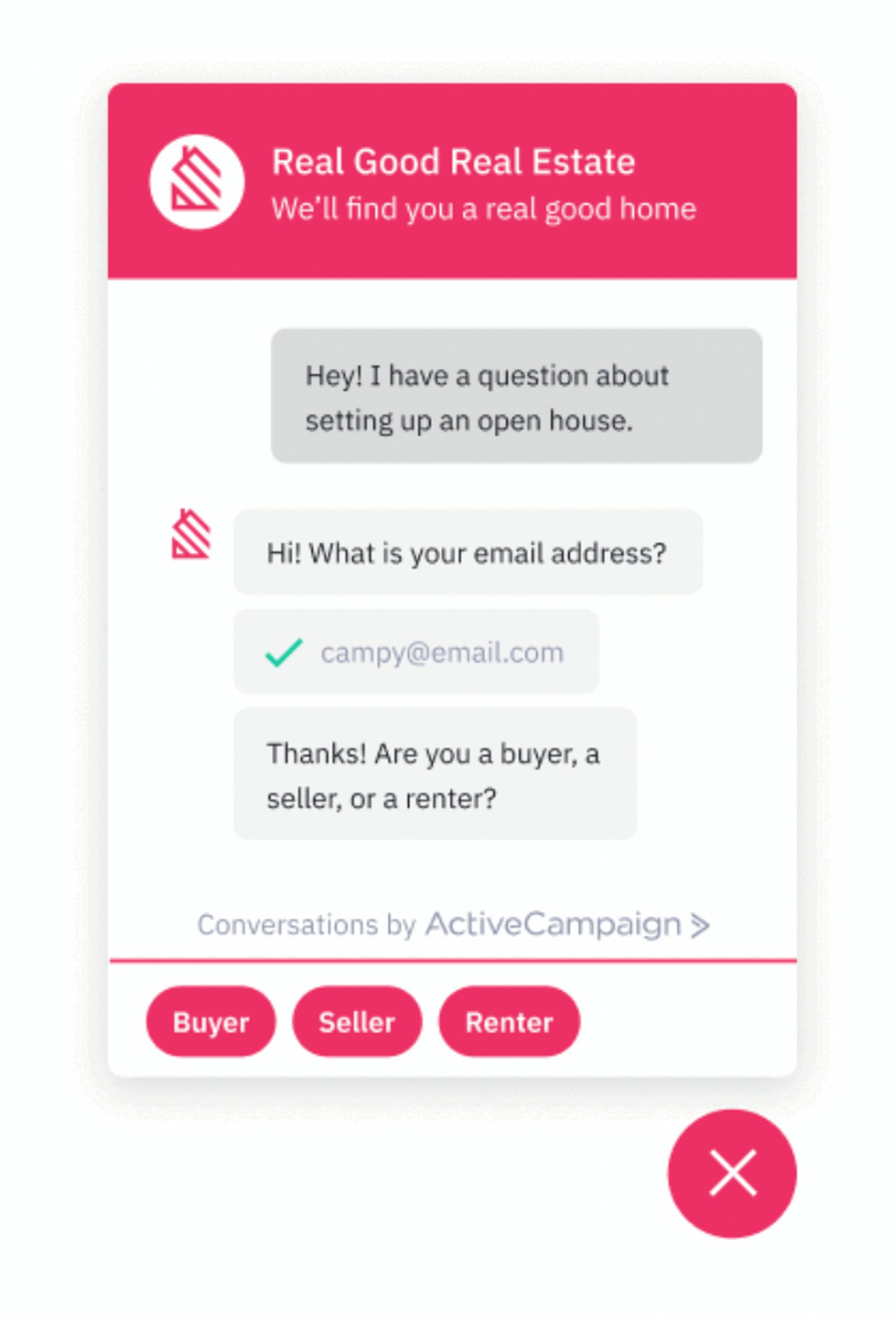
The last time I used live chat was instructive. I was interested in getting a copywriting course from the fantastic copywriter Joanna Wiebe. Just 1 problem—the course deadline was fast approaching, and I needed to set up a virtual credit card with the right amount of $$$ to pay. I wasn’t sure if there was sales tax.
If there was tax, my card wouldn’t have enough money to pay. So I really needed to know.
Fortunately, the landing page for the course had live chat. And even better, Joanna responded to my question within minutes.
And I bought the course.
Conversational marketing is a new trend, and the phrase “conversational marketing strategy” is definitely in danger of becoming a buzzword.
But it’s also part of a larger trend of permission marketing. Conversational marketing is on the rise as outbound marketing falls out of fashion in favor of inbound lead generation.
In fact, based on a survey conducted by Drift and Heinz Marketing in 2020, 8 out of 10 marketers said they were already using conversational marketing as part of their marketing strategy.
Inbound lead generation uses tactics like:
- Content marketing
- Personalization
- Email marketing
- Retargeting
- Data analytics
- A/B testing
Ready To Get Started?
5 ways to build a successful conversational marketing strategy
1. Respond in real time
Sometimes a question can’t wait. Or shouldn’t.
You know that feeling when you’re looking for an answer to a question, and it just feels like it should be easier to find? Your question seems like it should be common, yet you can’t find anyone answering it.
Often, this is the kind of question that an expert could answer in just a few seconds. But it seems impossible to find the answer online.
Boom! Enter conversational marketing.
Live chat means people can get instantaneous (or at least very fast) personal solutions to their questions.
And if you don’t have the resources to have live chat running 24/7 (after all, people need to sleep), chatbots can help people out in the meantime.
Why do people like your landing page? Is it:
- Because it’s aesthetically beautiful?
- Because it’s got fancy, interactive parts?
- Because it represents your brand well?
It’s none of those things. It all comes down to customer experience—specifically, how easy it is for customers to find the answers they need on your site.
When you use conversational marketing, you make it easier for people to find what they want. This means they like you more—and have the information they need before converting into a customer.
2. Mine chat logs for voice of customer language
Where do great marketing messages come from?
Before we answer that, let’s talk about where they don’t come from.
- Great marketing messages don’t come from the brain of a marketing executive.
- They don’t come from the brain of a copywriter.
- They don’t come from a 4-hour “brainstorm” in your largest conference room.
Great marketing messages come from your customers.
Legendary copywriter Eugene Schwartz once wrote: “There is your audience. There is the language. There are the words that they use.”
He’s in good company. Because legendary ad-man David Ogilvy (in many ways the inspiration for Don Draper’s character in Mad Men) once said: “Unless you have some reason to be solemn and pretentious, write your copy in the colloquial language which your customers use in everyday conversation.”
Marketers of old knew that great marketing comes from listening to your audience. What happens when you use the same words that they use?
- You catch their attention because you say things they’re already thinking.
- They feel like you understand them (because you do).
- They understand the value you offer. They know what you can do for them.
Ogilvy and Schwartz were marketers of a different period. But the old advice is still at play today.
The school of “conversion copywriting” draws on old-school lessons and applies them to modern marketing.
Imagine that you needed to create the copy and message for a rehab and addiction therapy center. Which headline would you choose?
- “Your Addiction Ends Here”
- “If You Think You Need Rehab, You Do”
Joanna Wiebe, the original conversion copywriter, doesn’t need to imagine this—because she actually did this project.
Here’s the winning page.

The headline “If you think you need rehab, you do” crushed the original headline, generating 400% more button clicks.
It was so much better that it even increased the conversion rate on the next page by 20%.
And here’s the best part—Joanna Wiebe didn’t write it.
Along with many other quotes, Eugene Schwartz once said, "Copy is not written. Copy is assembled.”
Joanna assembled this copy from voice-of-customer research. She read it in the Amazon reviews of a book on addiction. A customer literally wrote it.
What’s our point in all of this? What does this have to do with conversational marketing and converting traffic?
Chat logs are a goldmine of voice-of-customer language!
In chat logs, you can see exactly what problems your customers are asking about and the words they use to describe them.

In chat logs, your customers are literally talking to you.
Voice-of-customer language is the crucial ingredient of great marketing copy. Once you’ve got it, you can use it:
- On your website
- In your emails
- On landing pages
- In Facebook Ad copy
- In PPC ad copy
- In sales conversations
- In live chat!
Yup. Once you’ve mined your live chats to get good customer language, you can turn right back around and use that language to make your live chat and chatbots more effective at delivering relevant content.
3. Sound more human
Sometimes, salespeople and marketers get a bad rap.
As consumers, people often don’t want to feel like they’re being “sold to.”
Movies and popular media (and the phrase “sell me this pen”) make salespeople look extremely pushy.
Advice like:
- Always push to get the yes
- Always schedule the next meeting
- Follow-up over and over
This doesn’t help the perception of pushiness. Great salespeople don’t go overboard (and “consultative sales” is the latest, growing approach).
But the perception is there. Consumers are sometimes hesitant to talk to sales. Marketers aren’t free of blame, either.
Look around at some websites, and you’ll find vague buzzwords like:
- “Provide solutions”
- “Empower you to”
- “Leverage”
Marketers suffer from a “being understood” problem and a “people roll their eyes at us” problem.
Sales suffer from an “I don’t want to talk to you” problem.
But both problems have the same root—sounding like a business, marketer, or salesperson instead of a human.
People want to know how you can offer assistance. And sounding a little more human and conversational is an important step to getting them to listen to you.
Live chat (supported by voice-of-customer research and staffed by real people) creates authentic experiences that engage leads.
Having a human tone is hard to scale—if you have more people talking to you than people operating live chats, you could have long delays.
So even though it isn’t the same as talking to a real person, intelligent chatbots feel more personal and human than submitting a vague contact request form.
4. Offer more personalized experiences
Do you want to be treated like everyone else? Or do you want to be treated like a unique individual?
Kind of a no-brainer, right?
Personalization is 1 of the latest trends in marketing. Instead of treating everyone the same, doesn’t it make sense to treat them like individuals and solve their problems individually?
Even though “personalization” is a long word in danger of reaching buzzword territory, the underlying concept is simple. It’s just treating everyone like an individual.
As online competition continues to grow and customers have more brands to choose from, personalization is becoming an increasingly important factor in all companies’ marketing strategies.
According to Statista, 33% of businesses dedicated more than half of their marketing budgets to personalization in 2020.
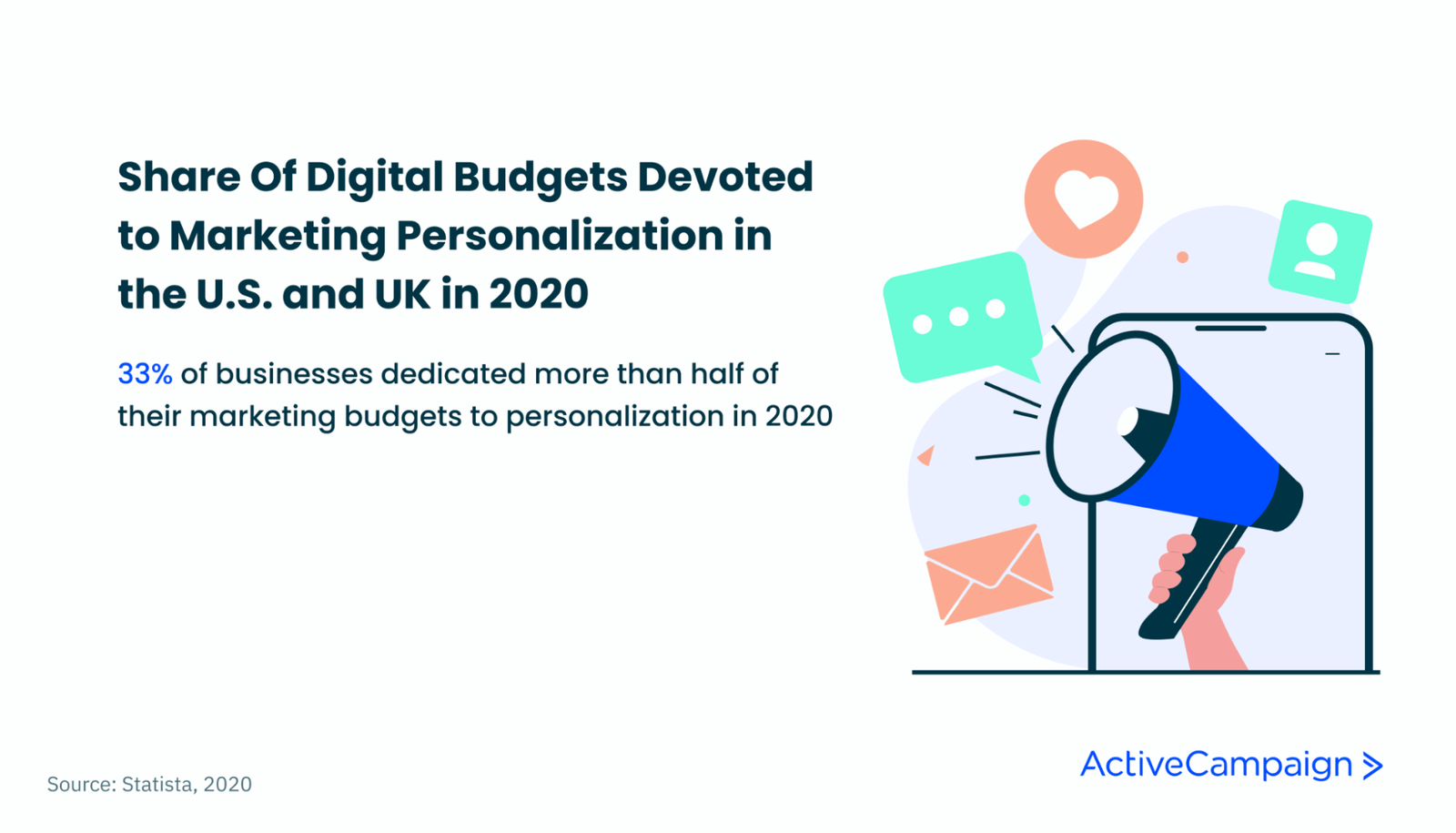
How does conversational marketing help you treat people like individuals?
- Solve individual problems on demand
- Break people out of generic funnels
- Collect additional information (and use it to follow up)
When people contact live chat or chatbots, they often have specific problems they’re dealing with. Instead of directing them to generic content that’s sort of about their problem, a live chat agent can provide human-to-human interaction.
It’s a much more personal customer service experience.
And, as you’ll see in point number 5, this kind of personalization can be useful to help people speed their way through your normal marketing and sales funnel.
Finally, live chat and chatbots allow you to collect information about qualified leads contacting you.
That could mean getting their phone number to follow up on a call. Or it could mean getting more information about their industry, company, needs, and challenges.
All of which you can later use to segment and target them. Learn more about segmenting your audience and how it’ll benefit your marketing strategy.
5. Qualify leads quickly
Here’s the typical online sales funnel:
- A prospect visits your website and clicks around a bit
- The prospect submits a form to get more information
- An automated email (or email series) goes out to nurture the prospect
- A sales rep follows up with the prospect directly
- The prospect either self-serves, talks to the sales rep, or exits the funnel
Don’t misunderstand—this system works. If done well, it can get extraordinary results for a variety of different types of businesses.
The typical online sales funnel has a few advantages:
- It happens at the prospect’s pace. The prospect initiates action and can get more information at their convenience.
- It’s mostly automated. Creating forms and nurturing emails works, no matter how many people you send through your funnel.
- It can reach people at every stage of the funnel. People at the top of the funnel, who’d otherwise leave because they aren’t ready to buy, can be reached and nurtured.
But there are also 2 major disadvantages:
- It’s slow
- It’s inefficient for people almost ready to buy
If you come to a website and are almost ready to buy the product, you don’t need to go through a whole sales funnel or marketing funnel. You just have a few questions to answer.
That’s where conversational marketing can excel—it helps you capture your most qualified leads.
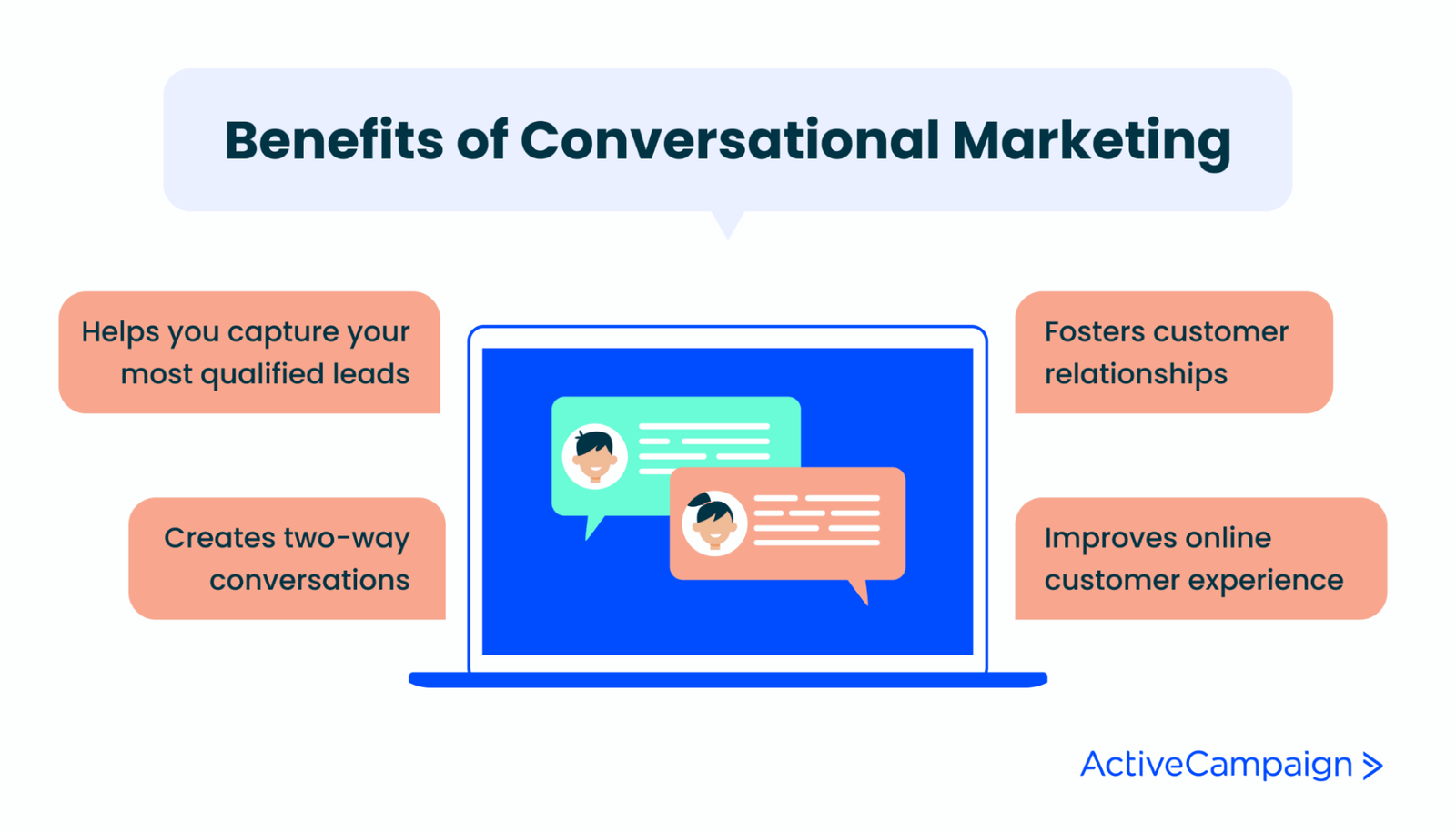
Someone reaching out via a chat widget is already far in their customer journey. Instead of having them submit lead forms and go through a nurture funnel where you try to infer their level of interest based on behavior—just ask them.
Live chat or chatbots can qualify your leads when they reach out to you. So instead of going through a bunch of steps before talking to a sales rep, your prospects can be qualified and sent to sales directly—or even invited to purchase right away (depending on what you sell).
Conversational marketing is a great addition to the sales pipeline because it answers some of the inefficiencies of the typical sales cycle.
Your most qualified leads are almost ready to buy.
So instead of making them jump through hoops, give them the answers to questions that are holding them back from converting into a conversational sale.
Frequently asked questions
What are the 3 phases of the conversational marketing framework?
The 3 main stages of conversational marketing are engage, understand, and recommend.
The engagement stage focuses on interacting with the customer and getting their contact details. Contrary to other marketing strategies, such as lead forms, contacts won’t have to wait for a response but can continue to engage with chatbots or employees via live chat.
In the understanding stage, your chatbots qualify leads by asking them questions to understand them better and give them the answers they need.
The recommending stage is where your bots route leads to suitable sales pages or people based on the product or service they need. Bots can even go as far as to assign a specific rep to a lead by booking meetings directly from conversations.
What are conversational ads?
Conversational ads are digital advertisements that leads can interact with via an automated chat conversation. Conversational ads can be Click-to-Messenger ads or Sponsored Messages and are most often used on social media platforms such as Facebook and LinkedIn.
Conversational ads can be in image or video format. Call-to-action buttons and customizable hashtags can also be added to these adverts to encourage people to spread the message to their followers.
Why are conversations important in an inbound strategy?
Real-time conversations can help your business deliver relationship-focused, precise, and consistent messages. It helps attract customers through the channels they prefer and gives them the answers they need as opposed to tons of information that isn’t relevant to their query. It’s great for qualifying leads and getting them to convert faster.
Conclusion: Is conversational marketing the future of marketing?
No. Yes. Maybe.
It’s highly unlikely that conversational marketing is the sole future of marketing strategy. Other marketing approaches still work and are important for parts of the sales cycle that conversational marketing doesn’t touch.
But conversational marketing is definitely part of the future of marketing. It all comes down to how well you implement your conversational strategy and how good your live chat and intelligent chatbots are at having meaningful conversations.
The sad reality is that although bots can be an effective marketing lead capture tool when done well, they often aren’t done well.
A series of tweets from Brennan Dunn, a segmentation expert and the founder of RightMessage, makes this point well.
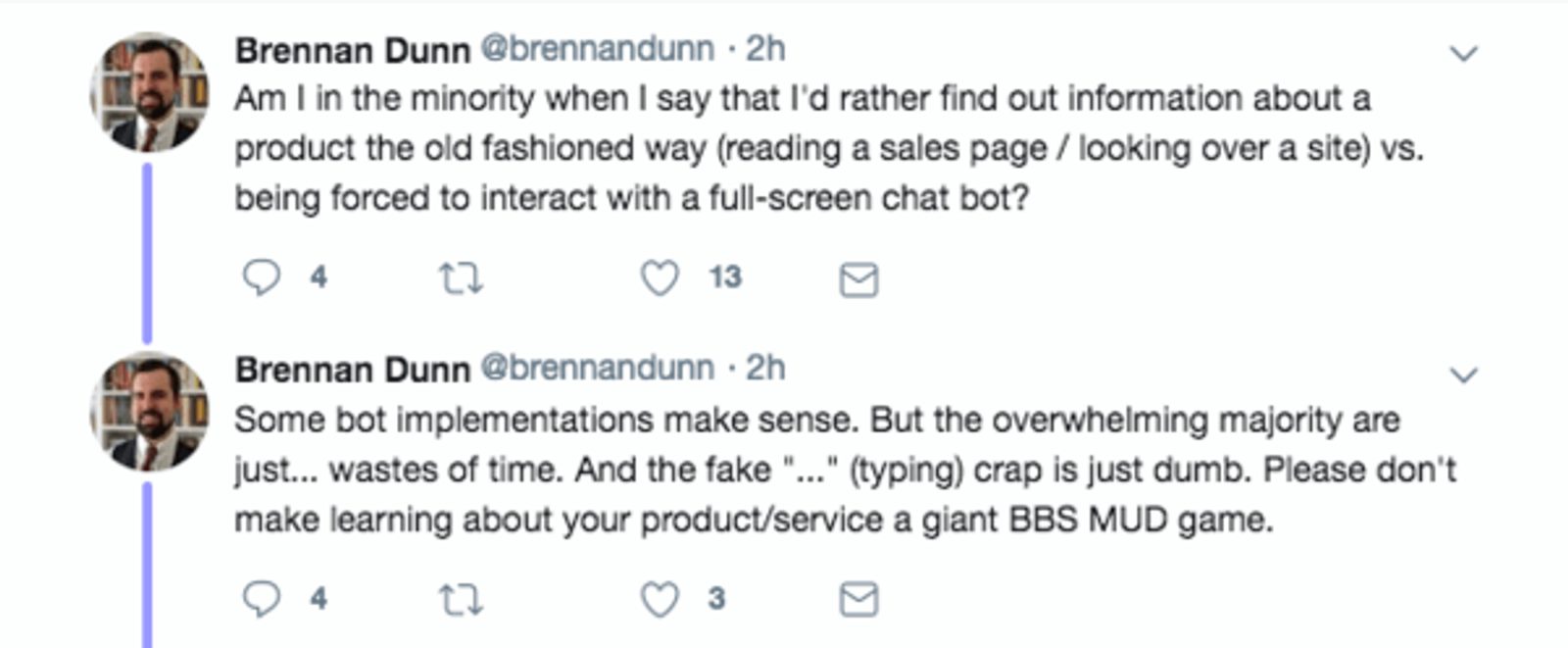
Implementation matters.
As he went on to argue, poorly implemented intelligent chatbots are the equivalent of those annoying “press 1 for X” that you hear when calling the doctor’s office or the DMV (minus, thankfully, the hold music).

As with any new technology, it’s easy to get over-enthusiastic.
Conversational marketing won’t completely replace the funnel systems that marketers are already using. And you can’t apply it blindly and expect results.
But, if done well, conversational marketing can help you:
- Respond in real-time
- Mine chat logs for information
- Sound more human
- Personalize your messages
- Convert traffic
- Take leads through the sales process quicker
- Deliver higher sales conversion rates
And, of course, it can switch your marketing from one-way communication to a 2-way conversation.
Are you interested in incorporating conversational marketing into your strategy? Have a look at ActiveCampaign’s Conversational Marketing and Live Chat Software.









